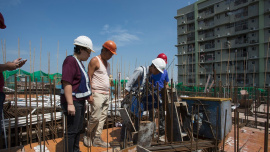The critical nature of the tourism industry for the development of Macau and the well being of its population is beyond question. For that reason, the discussion of the future of tourism development is a major policy matter, and the Macau Tourism Industry Development Master Plan, under public consultation for another week, deserves more attention than it has received so far. Four aspects seem to stand out when we discuss the future of tourism: the profile and number of visitors; the place or role of the casino industry in the sector; the expansion of non-gambling activities; and the implications of the sectors evolution on urban planning and management. These topics are inter-related but distinct and are touched on in the document, although not necessarily in the exact way defined above. But that is not the main issue. The point is that the document somehow gives the impression that the analytical effort was less than comprehensive. Take, for example, the characterisation of visitors. They are mainly categorised by place of origin, with the bulk, not surprisingly, coming from Mainland China and, more broadly, Greater China. Nothing is new there; the concentration of Macaus source markets is already well-established. However, very little effort is made to differentiate those source markets or to profile the visitors according to their interests and motivations, or their visiting and spending patterns. Can anyone disagree, in general terms, with the idea that the tourism industry in Macau should co-develop with other industries and carve out a unique set of target segments? And that doing so, is a challenge for the city? The issue is how to do this, how to define the targets, how realistic are they, and which tools are within our reach to achieve them. The documents take on these issues is less obvious, to say the least. From that very general definition of challenges, we jump, without really building an argument, to a list of so-called strategies, which encompass short and medium-term measures. That is all very well. They seem to imply a finer profiling of (desirable?) visitors. But whether well-defined approaches and criteria exist regarding the relative importance of those profiles and how to attract them is not clear. More should be done to substantiate the choices of objectives made and to define the proper tools to achieve them. Without these, the measures listed look more like a general wish list than a proper strategic development plan.
Top Stories
RELATED ARTICLESMORE FROM AUTHOR
【法律解碼】評估澳門《信託法》的進展:是否不負眾望?
第15/2022號法律(澳門《信託法》)於2022年12月1日正式生效。澳門自此成為葡語系首個設立在岸信託法的司法轄區,亦是繼《中華人民共和國信託法》、“台灣地區信託法”及《受託人條例(香港法例第29 章)》後,大中華地區第四部信託法。儘管澳門《信託法》至今已生效逾一年,但據了解,該法尚未得到有效實施,。因此有必要就當前的挑戰和未來的出路展開探討。
OPINION – Investing in Diversification!
As the lights of the Great Hall of the People in Beijing, where the “Two...
【時事評論】公共工程需考慮長遠經濟社會效益
在經濟衰退的時候,著名經濟學家凱恩斯就會被搬出來,為政府加大投資,大興土木的建設基礎設施以推動經濟發展背書。此一說法被詬病多時,然而不少政府及政治人物卻情有獨鍾,甚至樂此不疲。内地奉行鋼筋水泥經濟多時,這股基建風南下到港澳,澳門近年的基建或者大大小小的各項公共工程無日無之,這些能否推動澳門經濟高質發展?事實唔使問阿貴,作用並不顯著。























